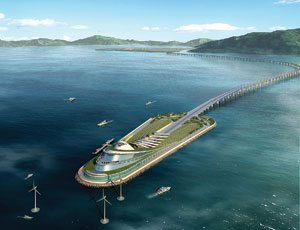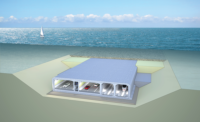A consortium led by Beijing-based China Communications Construction Co. has won the contract to design and build the world’s longest sunken-tube tunnel for road traffic between Hong Kong, Zhuhai and Macao. The project has a tight time frame, with design expected to be completed by June 2012 and construction slated to be finished by the end of 2016.

The winning project team includes the local offices of AECOM Asia Co. Ltd., Shanghai Urban Construction (Group) Co., China Highway Planning and Design Institute Inc., Denmark’s COWI A/S, Shanghai Tunnel Engineering and Rail Transit Design and Research Institute, and CCCC Fourth Harbor Engineering Investigation and Design Institute.
The project entails the design and construction of a 4.2-mile-long sunken tunnel and two artificial islands, along with work involving environmental mitigation, drainage, and traffic control and surveillance systems. The contract was awarded for an undisclosed amount.
The sunken tunnel is part of the overall Hong Kong-Zhuhai-Macao Bridge (HZMB) project, which calls for a series of bridges and tunnels totaling 18.4 miles. The entire project is estimated to cost $11 billion, which will be shared among the governments of China, Hong Kong and Macao.
Jin Ping Zhang, deputy general manager, COWI China, says many of her company’s engineers and specialists will come to Zhuhai to work on the project. “Otherwise, we could not do such a job in such a short time,” she says. “At the same time, we also have a team working in Denmark.”
Upon completion, the HZMB tunnel, to be constructed of approximately 32 elements, will be the world’s longest sunken-tube tunnel for road traffic. The current record-holder is the 2.2-mile Oresund Crossing tunnel between Denmark and Sweden.
In addition to the challenges brought by the tunnel’s length, depth (more than 40 meters) and soft seabed, engineers will have to address the accumulation of sediment and the risk of earthquakes at the site. Moreover, they will have to consider the tunnel’s impact on marine life. “White dolphins are a very sensitive and rare species in the Pearl River Delta,” notes Eric Ma, executive vice president of transportation, AECOM Asia Co. Ltd.
Sunken-tube tunnel technology is not new to China. According to Ma, 10 sunken-tube tunnels have been completed in the country, ranging from the 1972 Cross Harbour Tunnel in Hong Kong to the 2003 Waihuan Tunnel in Shanghai. In addition, the Fushan Zhujiang Tunnel and Tianjin Haihe Tunnel are currently under construction. Still, Ma says the HZMB sunken tunnel “is the most challenging one and the biggest one.”


Post a comment to this article
Report Abusive Comment